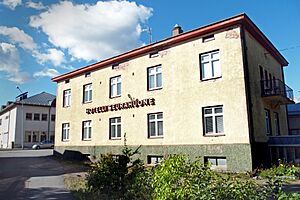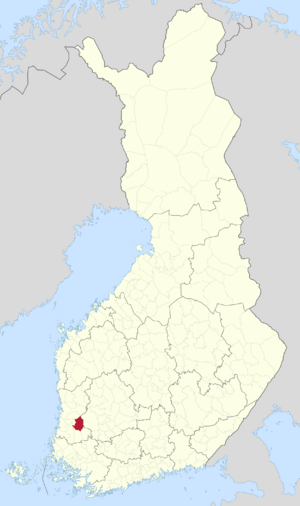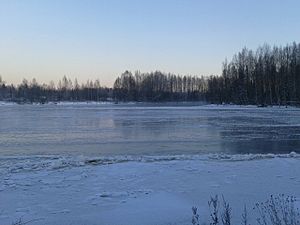Kokemäki facts for kids
Quick facts for kids
Kokemäki
Kumo
|
||
|---|---|---|
|
Town
|
||
| Kokemäen kaupunki Kumo stad |
||

An old hotel Seurahuone in Tulkkila, Kokemäki
|
||
|
||

Location of Kokemäki in Finland
|
||
| Country | ||
| Region | Satakunta | |
| Sub-region | Pori sub-region | |
| Parish | 1324 | |
| Charter | 1869 | |
| Town privileges | 1977 | |
| Area
(2018-01-01)
|
||
| • Total | 531.27 km2 (205.12 sq mi) | |
| • Land | 480.42 km2 (185.49 sq mi) | |
| • Water | 50.04 km2 (19.32 sq mi) | |
| Area rank | 181st largest in Finland | |
| Population
(2023-12-31)
|
||
| • Total | 6,766 | |
| • Rank | 136th largest in Finland | |
| • Density | 14.08/km2 (36.5/sq mi) | |
| Population by native language | ||
| • Finnish | 96.5% (official) | |
| • Swedish | 0.2% | |
| • Others | 3.3% | |
| Population by age | ||
| • 0 to 14 | 12.8% | |
| • 15 to 64 | 56.3% | |
| • 65 or older | 30.9% | |
| Time zone | UTC+02:00 (EET) | |
| • Summer (DST) | UTC+03:00 (EEST) | |
| Climate | Dfc | |
| Website | www.kokemaki.fi | |
Kokemäki (pronounced KO-ke-ma-kee) is a town and municipality in the Satakunta Region of Finland. It's also known as Kumo in Swedish. About 6,766 people live there. The town covers an area of 531.27 square kilometres (205.12 sq mi), with 50.04 km2 (19.32 sq mi) of that being water.
Finland has two official languages: Finnish and Swedish. However, most people in Kokemäki speak Finnish. Many younger people also understand or speak some English.
An American company called Æsir Technologies Inc. plans to build a factory in Peipohja, a village in Kokemäki. This factory will make materials for special batteries called nickel-zinc batteries.
The coat of arms of Kokemäki shows a bishop's mitre, which is a special hat worn by bishops.
Contents
Geography
The Kokemäki River (Kokemäenjoki) is 121 kilometers long. It starts from Lake Liekovesi and flows through Kokemäki. Then, it empties into the Gulf of Bothnia near Pori.
The Kolsi hydro-electric power plant is located in Kokemäki. This plant uses the power of the river to make electricity. The Kokemäki River has always been important for travel and is known for its fish like salmon, whitefish, and lamprey.
Climate in Kokemäki
Kokemäki has a Subarctic climate. This means it has long, cold winters and short, mild summers. The weather changes a lot throughout the year.
History
People believe that an Iron Age town called Teljä was located near the Kokemäenjoki river in Kokemäki. The oldest stone carving ever found in Finland was discovered nearby in Huittinen. This carving is an elk's head and is about 8,000 to 9,000 years old! You can see it at the National Museum of Finland in Helsinki.
Archaeologists have also found items from the Middle Ages in Kokemäki. It is thought that Kokemäki was founded in the 12th century, or even earlier. The local church parish was set up in 1324.
Kokemäki was an important administrative center for the historical region of Satakunta until 1634. There was even a medieval Kokemäki Castle, but it was torn down in 1367.
An old trading route called Huovintie passed through Kokemäki. This route went from Turku along the Kokemäenjoki river. Along this route, there were special houses where travelers could stay overnight. One of these was near the Kokemäki church.
A legend says that in 1156, Bishop Henry visited Satakunta. He was on a trip to spread Christianity. St. Henry's Chapel is a beautiful brick chapel built in 1857. It stands where an old wooden building used to be. This old building might have been used by Bishop Henry himself! It could be the oldest wooden building still standing in Finland.
Kokemäki became an official town in 1869. Later, in 1977, it was granted city status. In 1969, the nearby municipality of Kauvatsa joined with Kokemäki.
Transport
Finland has a very good transport system with many roads.
Road Travel
Several main roads pass near Kokemäki. Highway 2 goes south of the town, connecting Helsinki to Pori. Highway 11 briefly passes through the northern part of Kokemäki. Highway 12 goes through nearby Huittinen.
Driving to Helsinki from Kokemäki takes about two and a half hours. You can find two electric vehicle (EV) charging points in Kokemäki.
Private bus companies like OnniBus and ExpressBus offer services to many towns and regions across Finland.
Train Travel
Finnish trains are known for being comfortable and clean. The state-owned train company, VR, has a service between Tampere and Pori. This train stops at Kokemäki.
The train station is about 3 kilometers west of the town center, in Peipohja.
Air Travel
The closest airport is Pori Airport, which is about 43 kilometers away. It takes about 40 minutes to get there by car.
Tampere–Pirkkala Airport is a bit further, about 96 kilometers away. It takes about an hour and ten minutes to reach.
The largest airport, Helsinki-Vantaa Airport, is about two hours and twenty minutes away by car.
Tourist attractions
There are many interesting places to visit in Kokemäki:
- St. Henry's Chapel
- Tulkkila - Museum Bridge
- Vestry of Saint Maria's Church
- Puurijärvi-Isosuo National Park
- Museum of Agriculture (Maatalousmuseo)
- Open-air Museum
- Kokemäenjoki river
- Kriivari Reindeer Farm
- Sapila Suspension Bridge
- Church of Gustav lll
Education
Finland's education system is well-known for being excellent. It's based on comprehensive schooling and is paid for by the government.
Kokemäki has six schools that offer primary and secondary education. These schools are Tuomaala, Tulkkila, Riste, Peipohja, Lahteenmaki, and Korkeaoja High School. All children aged 6 can get free pre-school education. For younger children, the Peipohjan day-care nursery takes care of kids from 9 months to 5 years old.
There is also a special school called Forsby School for children aged 0–9 who have special needs.
If you're interested in learning a trade, vocational training is available. This is provided by the Satakunta Training Consortium (SATAEDU) and Huittinen Business and Vocational College.
International relations
Kokemäki has special connections with other towns around the world. These are called "twin towns" or "sister cities."
 Falköping, Sweden
Falköping, Sweden Lier, Norway
Lier, Norway Mariagerfjord, Denmark
Mariagerfjord, Denmark Põltsamaa, Estonia
Põltsamaa, Estonia
See also
 In Spanish: Kokemäki para niños
In Spanish: Kokemäki para niños



